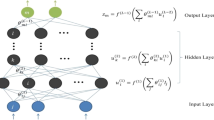Abstract
Multipath fading is one of the most serious problems in mobile communications. Various methods to solve or mitigate it have been proposed in time or frequency domain. Previously we proposed a channel prediction method that combines complex-valued neural networks and chirp z-transform that utilizes both the time- and frequency-domain representation, resulting in much higher performance. In this paper, we propose to deal with polarization additionally in its adaptive channel prediction to improve the performance further. A preliminary experiment demonstrates improvement larger than what is expected by a simple diversity gain.
Access this chapter
Tax calculation will be finalised at checkout
Purchases are for personal use only
Similar content being viewed by others
References
Maehara, F., Sasamori, F., Takahata, F.: Linear predictive maximal ratio combining transmitter diversity for OFDM-TDMA/TDD systems. IEICE Trans. Commun. E86–B, 221–229 (2003)
Bui, H., Ogawa, Y., Nishimura, T., Ohgane, T.: Performance evaluation of a multi-user MIMO system with prediction of time-varying indoor channels. IEEE Trans. Antennas Propag. 61(1), 371–379 (2012)
Eyceoz, T., Duel-Hallen, A., Hallen, H.: Prediction of fast fading parameters by resolving the interference pattern. In: Proceedings of the Asilomar Conference on Signals, Systems, and Computers, vol. 1, pp. 167–171 (1997)
Eyceoz, T., Duel-Hallen, A., Hallen, H.: Deterministic channel modeling and long range prediction of fast fading mobile radio channels. IEEE Trans. Commun. Lett. 2(9), 254–256 (1998)
Arredondo, A., Dandekar, K., Xu, G.: Vector channel modeling and prediction for the improvement of downlink received power. IEEE Trans. Commun. 50(7), 1121–1129 (2002)
Sternad, M., Aronsson, D.: Channel estimation and prediction for adaptive OFDM downlinks. In: Proceedings of the IEEE Vehicular Technology Conference 2003-Fall, vol. 2, pp. 1283–1287, October 2003
Liu, W., Yang, L.-L., Hanzo, L.: Recurrent neural network based narrowband channel prediction. In: Proceedings of the IEEE Vehicular Technology Conference 2006-Spring, vol. 5, pp. 2173–2177, May 2006
Potter, C., Venayagmoorthy, G.K., Kosbar, K.: RNN based MIMO channel prediction. Sign. Proces. 90, 440–450 (2010)
Ding, T., Hirose, A.: Fading channel prediction based on combination of complex-valued neural networks and chirp z-transform. IEEE Trans. Neural Networks Learn. Syst. 25, 1686–1695 (2014)
Tan, S., Hirose, A.: Low-calculation-cost fading channel prediction using chirp z-transform. Electron. Lett. 45(8), 418–420 (2009)
Ozawa, S., Tan, S., Hirose, A.: Channel prediction experiment based on linear prediction in frequency domain. In: Asia-Pacific Microwave Conference (APMC, 2010), Yokohama, pp. 1280–1283, December 2010
Ozawa, S., Tan, S., Hirose, A.: Errors in channel prediction based on linear prediction in the frequency domain: a combination of frequency-domain and time-domain techniques. URSI Radio Sci. Bull. 337, 25–29 (2011)
Matsui, H., Hirose, A.: Nonlinear prediction of frequency-domain channel parameters for channel prediction in fading and fast doppler-shift change environment. In: International Symposium on Antennas and Propagation (ISAP), pp. 1132–1135 (2012)
Ding, T., Hirose, A.: Fading channel prediction based on complex-valued neural networks in frequency domain. In: International Symposium on Electromagnetic Theory (EMTS 2013), Hiroshima, pp. 640–643. IEICE, May 2013
Ding, T., Hirose, A.: Fading channel prediction based on self-optimizing neural networks. In: Loo, C.K., Yap, K.S., Wong, K.W., Teoh, A., Huang, K. (eds.) ICONIP 2014, Part I. LNCS, vol. 8834, pp. 175–182. Springer, Heidelberg (2014)
Author information
Authors and Affiliations
Corresponding author
Editor information
Editors and Affiliations
Rights and permissions
Copyright information
© 2015 Springer International Publishing Switzerland
About this paper
Cite this paper
Murata, T., Ding, T., Hirose, A. (2015). Proposal of Channel Prediction by Complex-Valued Neural Networks that Deals with Polarization as a Transverse Wave Entity. In: Arik, S., Huang, T., Lai, W., Liu, Q. (eds) Neural Information Processing. ICONIP 2015. Lecture Notes in Computer Science(), vol 9491. Springer, Cham. https://doi.org/10.1007/978-3-319-26555-1_61
Download citation
DOI: https://doi.org/10.1007/978-3-319-26555-1_61
Published:
Publisher Name: Springer, Cham
Print ISBN: 978-3-319-26554-4
Online ISBN: 978-3-319-26555-1
eBook Packages: Computer ScienceComputer Science (R0)




